Large-Scale Freezing of Biologics: Understanding Protein and Solute Concentration Changes in a Cryovessel—Part 2
ABSTRACT
This two-part article series presents an in-depth look at the process of freezing and solute distribution in cryovessels by using a scale-down model called the cryowedge. Part 1, published in the June issue of BioPharm International, discussed the evolution of solute distribution in the cryowedge during the freezing process. Here in Part 2, we discuss protein and solute cryoconcentration changes in the cryovessel. For the study, we prepared a comprehensive map of frozen state solute distribution in terms of protein concentration and osmolality. Solution properties were measured on core samples removed from the frozen mass and compared with data obtained from solution samples removed during the freezing process (presented in Part 1). The results are in general agreement. An approximately three-fold cryoconcentration was observed. The properties of the frozen mass as a function of depth in the cryowedge were assessed and the results suggest a significant effect of convection on protein concentration, osmolality, and density distribution during freezing. Active freezing systems can affect the overall distribution of ice and solute in the matrix, i.e., the macro-cryoconcentration, but not the micro-cryoconcentration experienced by the solute and protein in the matrix.
Freeze-thaw operations represent a critical step in protein drug product manufacturing. Maintaining the protein quality during freezing, frozen storage, and thawing operations is challenging, especially at large scales. One factor that can affect protein quality is the protein and solute distribution that results from a freezing operation. A few studies have been reported on solute distribution in various freeze systems. A study that mapped the performance concentration and osmolality of 2-L polyethylene terephthalate glycol (PETG) bottles frozen at –20 °C or –80 °C found that the maximal concentration is centered in the lower half of the bottle.1 The protein concentration and osmolality were increased by a factor of ~2. Another study of the solute distribution for a monoclonal antibody (MAb) solution in 4-L high density polyethylene (HDPE) bottles, after thawing but before mixing, found that an ~3-fold concentration factor was preserved in the lower portions of the bottle.2 Similar results were seen in the frozen state in 1-L HDPE bottles in the lower and center portion of the bottle when the protein solution was frozen from 25 °C to –20 °C. In a 20-L carboy filled with 16 L of MAb solution and frozen at –70 °C, an ~9.3-fold increase in protein concentration and an osmolality increase of ~7-fold were reported at the last point to freeze.3 On the other hand, for Celsius bags (30-mL, Sartorius-Stedim Biotech, Aubagne, France), an ~2-fold increase in protein concentration and osmolality were observed. Freeze concentration effects also were evaluated for various bottle systems and the cryowedge system for 1 mg/mL bovine serum albumin (BSA) in buffer.4
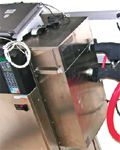
Pfizer, Inc.
The geometry of the cryowedge represents a scaled-down model of commercially available controlled-rate freeze-thaw systems called cryovessels. The heat and mass transfer surfaces and distances in the wedge are identical to those in a cryovessel of corresponding size, allowing the freeze and thaw behavior of a full-scale vessel to be studied at laboratory scale. An ~1.3-fold increase in protein concentration in the Cryowedge 20 system (Sartorius-Stedim) was reported, representing a 20-L cryovessel.4 The highest concentration was recorded near the last point to freeze in the wedge, and no significant depth variation was seen at this point. On the other hand, freezing in 1-L bottles increased BSA concentration ~4.6-fold (when frozen at –20 °C) and a >8-fold (when frozen at –80 °C). These concentration hot spots were found near the bottom center of the bottles. For small tubes and vials, the extent of cryoconcentration was lower (1.1 to 1.5-fold). It was concluded that ice-front velocity was the critical factor in determining the extent of bulk-scale freeze concentration;4 faster freezing led to a smaller overall degree of cryoconcentration. The objective of the studies described in this article series was to examine the behavior of proteins and solutes in the cryovessels, because this behavior ultimately determines the outcome of the frozen state storage. In Part 1, solute distribution and solution property changes during freezing were mapped for various processing rates as a function of position in the cryowedge.5 This Part 2 presents an exhaustive and comprehensive protein concentration and osmolality map in the frozen state as a function of cryowedge solution depth. We found that convective effects become important and are likely unavoidable for the distribution of solutes in practical systems.
MATERIALS AND METHODS
Materials
Solute distribution and solution property changes in the frozen state were monitored in a Cryowedge 34 (Sartorius-Stedim). Processing was carried out by a Cryoproccessor B using silicone oil as the heat transfer fluid (HTF, Syltherm, Dow). An in-house IgG2 MAb solution at 20 mg/mL in a 20 mM histidine buffer, pH 5.5 with 0.2 mg/mL polysorbate 80, 84 mg/mL trehalose dihydrate was used as a model protein for this study.
Polytetrafluoroethylene (PTFE) dry lubricant (Loctite Krytox RFE) was purchased from DuPont, Inc. (Johnston, IA). A bench-top band saw (Delta SM400 Shopmaster 3 Amp 9-inch band-saw) was used to cut the frozen cryowedge piece, and a Dewalt drill with a custom-made drill bit (diameter: 1.5 cm) was used to take cores (~2.5 cm long) from the ice.
Cryowedge Mapping in the Frozen State
The intermediate freezing process profile (defined in Part 1) was used for mapping the solute distribution in the frozen state for the formulation buffer solution and the MAb solution.5 Removing the frozen block of solution from the cryowedge posed a significant challenge because the bottom surface of the frozen ice block adhered strongly to the cryowedge surface. Running the thaw cycle for a short period to melt the ice from the edges did not solve the problem. In the case of the formulation buffer, a thin coat of PTFE dry lubricant, when sprayed and allowed to dry on the bottom of the cryowedge, enabled the frozen block to be removed. Approximately 4 L of formulation buffer were added to the cryowedge and frozen. After the solution went through the freeze cycle, the edges of the frozen block inside the cryowedge were thawed slightly to loosen and remove the block from the Cryowedge. The block was stored at –40 °C until further processing. This method of removing the frozen block did not work for the MAb solution, however. Instead, an aluminum foil interior mold of the cryowedge was prepared. The MAb solution was poured into the aluminum foil and then subjected to the freezing cycle. After thawing the sides, the frozen block could be removed easily and stored at –40 °C until further processing. To ensure that the heat transfer properties of the system were not significantly altered by the aluminum foil, a control experiment was performed by freezing water with and without aluminum foil. A comparison of the temperature profiles recorded by the five thermocouples showed identical thermal behavior between the two (data not shown).
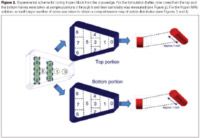
Figure 1
The frozen block was cut according to a predetermined template around positions 0 through 8 (Figure 1). These portions were further cut into two pieces each to represent the top and bottom halves of the frozen block. These smaller pieces were then drilled to obtain ~2.5 cm long cores. For the block made with formulation buffer solution, cores were taken only at the sample port positions (Figure 1 in Part 1).5 The frozen block of MAb solution was extensively cored in both the top and bottom halves to develop a detailed map of the solute and protein distribution. These samples were analyzed for pH, glass transition temperature (Tg'), osmolality, density, and high molecular mass species (soluble aggregates) by size exclusion chromatography (SEC) and protein concentration. No changes were seen in pH, Tg', or aggregation levels, and therefore, these data are not discussed here.
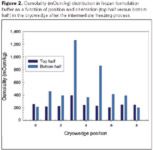
Figure 2
RESULTS
Mapping the protein and solute in the frozen state allows us to understand the stress that protein is subject to during frozen storage. Another objective of mapping the solution properties during the freezing process and after freezing was to determine if the changes occurring in the liquid phase during freezing are representative of the final solid phase. Ice cores were taken from the frozen block and osmolality and protein concentrations were measured. A core sample from the frozen block represents an average concentration of solutes and protein at that position because the ice sampled in the core dilutes the sample after it is melted for analysis. The implication of this on the measurement of cryoconcentration is discussed later.
Mapping of Solute and Protein in Frozen State
Cryowedge mapping during freezing as a function of freezing rate and time provided information on the development of solute and protein distribution.5 A key question is whether the solute distribution observed during freezing is sustained in the frozen state. This was addressed by coring blocks of formulation buffer and of MAb solution that were frozen using the intermediate cycle described in Part 1.5 The coring configuration for the frozen block is shown in Figure 1. Cores also were obtained from upper and lower halves of the ice block to assess the convective effects on cryoconcentration.
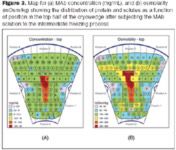
Figure 3
Formulation Buffer
The cores obtained from the cryowedge corresponding to positions 0–8 (Figure 1 in Part 1)5 for the upper and lower half of the frozen block were tested for osmolality. Data are shown in Figure 2 and a clear difference is seen between the two halves. In the top half, the osmolality ranged from 203 to 395 mOsm/kg, with the highest value at position 3. The osmolality values for the bottom half ranged from 200 to 1,291 mOsm/kg, with the highest value also at position 3. These data show that depth has a large effect on the outcome of the freezing process. This observation is significant, considering that the solution depth in the cryowedge was only ~7.5 cm, whereas 200- and 300-L cryovessels can be as deep as 107 and 130 cm, respectively (Sartorius-Stedim Cryovessel specification).
MAb Solution
A detailed and comprehensive map of the MAb solution frozen in the cryowedge was performed by taking cores at various positions from the top and bottom halves as shown in Figure 3 and 4. Small portions of the frozen MAb solution block had to be thawed from the sides (shown as white regions in the figures) to be able to remove the block from the wedge as discussed earlier in the methods section. A total of 107 cores were taken from the top half and 95 from the bottom half. These samples were analyzed for protein concentration and osmolality. Density also was measured of material collected from the region around sampling ports 0–8.
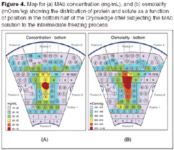
Figure 4
Figure 3a shows a map of protein concentration distribution obtained for the top half of the frozen MAb solution block. The measured concentration ranged from 3.8 to 21.7 mg/mL. The highest protein concentration was observed for core sample 5 from position 5, followed by core sample 8 from position 3, with a concentration of 21 mg/mL. The lowest protein concentrations were observed for the edge cores that were closest to the active heat transfer surfaces.
The greatest degree of solute exclusion occurred at the initial phase of ice formation because there is a larger liquid volume for the solutes to diffuse into. At the same time, the linear velocity of the ice front is slower because ice is being formed over a broader front. This reduces the amount of entrapped solute near the heat transfer surfaces. Progressive ice formation eventually concentrates the solutes into the region near the last point to freeze, around position 3. The osmolality contour map is shown in Figure 3b. The map for protein concentration and osmolality are broadly similar (Figures 3a and b). The highest osmolality value was at core sample 8 for position 3 (339 mOsm/kg) followed by core 5 at position 5 (329 mOsm/kg) as compared to the initial value of 270 mOsm/kg.
Protein concentration mapping for the bottom half of the frozen block is shown in Figure 4a. The relative spatial concentration distribution in the bottom half is similar to the top, but a significant difference in the absolute protein concentrations is seen between the two halves (Figure 3a compared to Figure 4a). The concentration at the edges was approximately 10 to 30 mg/mL, whereas on the top half, the edge concentration ranged from 2 to 12.5 mg/mL. The highest protein concentration measured was 65.1 mg/mL (core 2, position 3), which was three times higher than the starting concentration as well as the highest concentration observed for the top half. Osmolality values also demonstrated a similar pattern to protein concentration (Figure 4b). The maximum osmolality of 1,132 mOsm/kg (core 2, position 3) corresponds to a >4-fold increase from the initial osmolality value of 270 mOsm/kg.

Figure 5
An assessment of the fraction of total protein mass affected by cryoconcentration effect was performed. Figure 5a shows the data as a percentage of affected protein mass for the top half of the Cryowedge. The top half shows lower concentrations than the nominal for most of the fractions. Approximately 14% of the total protein was at concentrations between 0 and 9 mg/mL whereas the majority of the mass (~77%) was at concentrations between 9 and 12.5 mg/mL. The most concentrated region (19.5 to 23 mg/mL) accounted for 20% of the total protein in the initial solution load. Along similar lines, the osmolality distribution had three distinct regions of 90–140 mOsm/kg, 140–190 mOsm/kg, and 190–240 mOsm/kg which accounted for 25, 44, and 17% respectively, followed by a small region of 14% where osmolality values were between 240 to 340 mOsm/kg (Figure 5b). Analysis of the bottom half shows that ~48% of the total protein was at a concentration range of 10–20 mg/mL, whereas 32, 14, 5, and 11% lay in concentration ranges between 20 and 30 mg/mL, 30 and 40 mg/mL, 40 and 50 mg/mL, and 60 and 70 mg/mL, respectively (Figure 5a). Osmolality trended in a similar fashion: 150–315 mOsm/kg and 315–480 mOsm/kg accounted for 52 and 27%, respectively. The highest osmolality fraction (975–1,140 mOsm/kg) accounted for ~3% of the solution (Figure 5b).
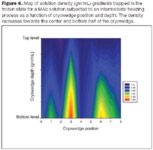
Figure 6
Material was collected from around each sample port position (Figure 1 in Part 1) for the top and bottom half of the MAb solution block, and density was measured on the resulting thawed solution. Figure 6 shows the contour map for the solution density gradient trapped in the frozen state as a function of cryowedge depth and sample position. The highest solution density is seen around position 3 and is higher in the bottom halves. It is likely that the concentration and osmolality differences between the top and bottom halves (in a relatively small total depth of 7.5 cm) is a consequence of a convective effect created by these density gradients in solution during cooling.
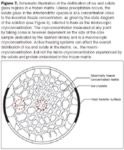
Figure 7
Several studies have been published investigating cryoconcentration effects in various freezing systems, as reviewed in the introduction. The reported results from these studies are in general agreement with the results observed in our study. With all the current results and previous studies taken together, it is clear that cryoconcentration is inevitable for all practical-scale freezing systems. Additionally, the extent of freeze concentration may be proportional to the solution depth because of density gradient-driven convection during the freezing process.
DISCUSSION
A comprehensive picture of the freezing behavior in a Cryowedge 34 (representative of a 300-L cryovessel) has been obtained during freezing as well as in the frozen state. Broadly, the cryoconcentration effects measurable in the liquid phase as the solution freezes (presented in Part 1) are preserved in the frozen state. Approximately 3% of the solutes are affected by the highest level of cryoconcentration (concentration >40 mg/mL). The levels of cryoconcentration observed here compare well to those seen in previous reports for the Cryowedge 20 (20-L cryovessel), in which the cryoconcentration level of 99.5% of the total protein was less than 1.2X.4
However, there are some important differences from earlier reported results.4 The main finding is the significant impact of depth on the cryoconcentration effect, whereas earlier results found no effect of depth. This difference is likely a consequence of the composition of the solution. The solution studied here contains 20 mg/mL MAb in 20 mM histidine buffer as well as 84 mg/mL trehalose dihydrate, whereas the earlier reports studied a BSA solution at 1 mg/mL in 10 mM citrate buffer only. Disaccharide solutions have significant temperature coefficients for density and viscosity compared to water or buffer solution alone. In separate measurements, an increase in density of 0.0025 g/mL for the disaccharide solution (84 mg/mL trehalose in buffer) as opposed to 0.00096 g/mL for buffer solution alone, was observed on cooling from 25 to 5 °C. As the solution cools, small temperature differences lead to density gradients, which create convection currents. Material with higher density, i.e., materials containing a higher concentration of solutes, sinks to the bottom. Thus, in the freezing of solutions containing high concentrations of solutes, there is a combination of convection- and diffusion-driven cryoconcentration effect, both toward the bottom and toward the last point to freeze, simultaneously. Although it is not known how this effect translates to large cryovessels with greater available depth of liquid, it is quite likely that a large fraction of solution in the upper regions is significantly low in disaccharide concentration. If the disaccharide has a critical concentration to be effective as a cryoprotectant, this function could potentially be compromised. We are currently exploring this question by placing cores from various positions in the frozen block on long-term stability. Similarly, the high concentration of disaccharides in the lower regions could lead to the possibility of exceeding solubility limits or crystallization.
Interestingly, in another study of the Cryowedge 20, cryoconcentration effects larger than those seen here were found.6 That study looked at various buffers as well as fully formulated MAbs. Sampling also was performed by coring the ice. Cryoconcetration effects at the last point to freeze were found to be 12-fold (sodium citrate buffer), 24-fold (histidine buffer), and 20-fold (NaCl solution). A possible reason for the discrepancy could be the size of the cores as discussed below.
Micro- and Macro-cryoconcentration
The term cryoconcentration as used in the literature and in this paper requires clarification. The method used here to measure cryoconcentration actually gives a macroscopic value that is somewhat dependent on the sampling method and the core dimensions. An ice core samples a combination of ice as well as frozen solute matrix (Figure 7). When melted and analyzed, the pure-ice fraction dilutes and dissolves the solute fraction, giving a lower-than-true cryoconcentration value, as is apparent in the two dashed circles in Figure 7. The size of the core and its position will therefore determine the value measured, and should be referred to as a macro-cryoconcentration value. The true or micro-cryoconcentration can be explained as follows: As freezing proceeds, ice formation excludes solutes (including protein) from the growing ice crystal. Solutes migrate in front of the growing ice front that consist of small finger-like projections called dendrites.7,8 These dendrites trap some of the solute as they grow. Therefore, solute is found in all regions of the block instead of only at the last point to freeze. However, as the solution trapped between dendrites freezes, it continues to undergo cryoconcentration as the water component is removed as ice and the composition changes, following the freezing boundary curve in Figure 8. The solute potentially can precipitate if its solubility limit is reached at the eutectic point. If precipitation is hindered, the solutes would be cryoconcentrated to a value close to the theoretical maximal freeze concentration given by the phase or state diagram (Figure 8). This represents the true conditions experienced by the protein and should be called the microscopic cryoconcentration. Thus, for the system containing trehalose (and most other disaccharides when precipitation is hindered), the maximal freeze concentration value is approximately 80% w/w.9 This represents cryoconcentration by a factor of ~10 in our system. The protein concentration in this matrix therefore is 200 mg/mL, significantly higher than measured when macroscopic sampling is performed and reported.
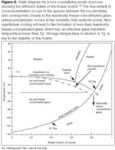
Figure 8
From a unit-operations' perspective, process parameters will affect the rate of heat removal, ice formation, and convection, and thus determine the macro-cryoconcentration distribution in the frozen matrix. However, in the macro-cryoconcentrated matrix, the protein and solute molecules will be in an environment determined by thermodynamics, i.e., by the phase or state diagram. Storage temperature in relation to Tg' is key to the stability of this matrix.
CONCLUSIONS
The results from mapping the frozen state suggest that cryoconcentration is preserved in the frozen state and the observed macro-cryoconcentration values during freezing were in general agreement with frozen state values. The extent of macro-cryoconcentration (measured by cores) varied between the top and bottom halves of the frozen block. The significantly higher macro-cryoconcentration in the lower half of the cryowedge can be explained by the presence of disaccharide in the formulation and formation of temperature-induced density gradients. When freezing a protein solution containing an additive that shows significant changes in density with temperature, a cooling-induced density gradient is created that leads to convective flow of solution. This causes the lower regions of the solution to cryoconcentrate to a greater extent than the upper regions. However, looking fundamentally at the changes occurring during the freezing process tells us that the true extent of (micro-)cryoconcentration experienced by the protein in the inter-dendritic spaces can be estimated from a phase or state diagram for the major solute component. This is significantly higher than what is measured as macro-cryoconcentration. Active freezing systems can affect the overall distribution of ice and solute in the matrix, i.e., the macro-cryoconcentration, but not the micro-cryoconcentration experienced by the solute and protein embedded in the matrix.
Parag Kolhe is a principal scientist, Alanta Lary is a senior scientist, Steven Chico is an associate scientist, Elisabeth Holding was an associate scientist, and Satish K. Singh is a research fellow, all at Pfizer, Inc., Chesterfield, MO, 636.247.9979, satish.singh@pfizer.com.
REFERENCES
1. Tschoepe M, Schmidt R. Impact of freeze/thaw processing on monoclonal antibody stability. Bioprocess International Conference. Vienna, April 2008.
2. Kolhe P, Badkar A. Protein and solute distribution in drug substance containers during frozen storage as well as post-thawing: a tool to understand and fefine freezing-thawing parameters. Biotechnol Proc Devel. Submitted 2009.
3. Lashmar UT, Vanderburgh M, Little SJ. Bulk Freeze–Thawing of macromolecules: effects of cryoconcentration on their formulation and stability. Bioprocess Int. 2007;5(6):44–54.
4. Webb SD, Webb JN, Hughes TG, Sesin DF, Kincaid AC. Freezing biopharmaceutical using common techniques and the magnitude of bulk scale freeze-concentration. Bioprocess Int. 2002;15(5):22–34.
5. Kolhe P, Holding E, Lary A, Chico S, Singh SK. Large-scale freezing of biologics: understanding protein and solute concentration changes in a cryovessel–part I. BioPharm Int. 2010;23(6):53–60.
6. Zippelius R. Untersuchung zum Enifrier- und Aufauverhalten Pharmazeutischer Humanproteinlosungen im Grossmasstab. (Investigation of freezing and thawing process of human pharmaceutical protein solutions at large scale). PhD Thesis (in German), Ludwig-Maximilians University, Munich, 2002.
7. Wisniewski R, Wu VL. Large-Scale Freezing and Thawing of Biopharmaceutical Products. In: Avis KE, Wu VL, ed. Biotechnology and Biopharmaceutical Manufacturing, Processing, and Preservation Vol 2 of Drug manufacturing technology series: CRC Press, 1996:7–60.
8. Muldrew K, Acker JP, Elliott JAW, McGann LE. The water to ice transition: Implications for living cells. In: Fuller BJ, Benson EE, Lane N, editors. Life in the frozen state. Boca Raton, FL. CRC Press; 2004:67–108.
9. Roos Y, Karel M. Applying state diagrams to food processing and development. Food Technol. 1991 Dec;45(12):66, 68–71, 107.
10. Singh SK, Kolhe P, Wang W, Nema S. Large-scale freezing of biologics—a practitioner's review part 1: fundamental aspects. Bioprocess Int. 2009;7(10):32–44.
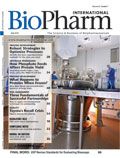
VERAXA and Voyager to Create Combined Business for Advancing Pipeline of Next-Gen Cancer Therapies
April 23rd 2025The proposed business combination would create a publicly traded, clinical-stage biopharmaceutical company that will focus on developing a pipeline of next-generation cancer therapies.
MHRA Approves GSK Therapy Combinations for Multiple Myeloma
April 21st 2025Belantamab mafodotin is approved in combination with bortezomib plus dexamethasone in patients who have had at least one prior therapy, and in combination with pomalidomide plus dexamethasone for those who have had a prior therapy including lenalidomide.
Tokyo University of Science Research Team Explores Improved Delivery of Antisense Oligonucleotides
April 18th 2025Using cholesterol-modified oligonucleotides, the research team aims to improve the delivery of antisense nucleotide-based therapies for treating neurodegenerative diseases and brain cancers.